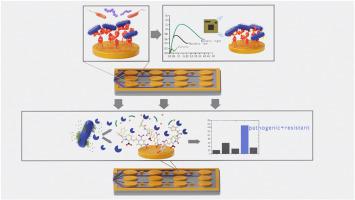当前位置:
X-MOL 学术
›
Biosens. Bioelectron.
›
论文详情
Our official English website, www.x-mol.net, welcomes your feedback! (Note: you will need to create a separate account there.)
A dual-channel electrochemical biosensor enables concurrent detection of pathogens and antibiotic resistance
Biosensors and Bioelectronics ( IF 12.6 ) Pub Date : 2024-04-20 , DOI: 10.1016/j.bios.2024.116314 Dharanivasan Gunasekaran , Irina Rostovsky , David Taussig , Talya Bar-Am , Yariv Wine , Neta Sal-Man , Sefi Vernick
Biosensors and Bioelectronics ( IF 12.6 ) Pub Date : 2024-04-20 , DOI: 10.1016/j.bios.2024.116314 Dharanivasan Gunasekaran , Irina Rostovsky , David Taussig , Talya Bar-Am , Yariv Wine , Neta Sal-Man , Sefi Vernick

|
Diarrheagenic infections, commonly treated with β-lactam antibiotics, contribute to antibiotic resistance - a pressing public health concern. Rapid monitoring of pathogen antibiotic resistance is vital to combat antimicrobial spread. Current bacterial diagnosis methods identify pathogens or determine antibiotic resistance separately, necessitating multiple assays. There is an urgent need for tools that simultaneously identify infectious agents and their antibiotic resistance at the point of care (POC). We developed an integrated electrochemical chip-based biosensor for detecting enteropathogenic (EPEC), a major neonatal diarrheal pathogen, using an antibody against a virulence marker, termed EspB, and the β-lactam resistance marker, β-lactamase. A dual-channel microfabricated chip, bio-functionalized with a specific EspB monoclonal antibody, and nitrocefin, a β -lactamase substrate was utilized. The chip facilitated electrochemical impedance spectroscopy (EIS)-based detection of EspB antigen and EspB-expressing bacteria. For β-lactam resistance profiling, a second channel enabled differential-pulse voltammetric (DPV) measurement of hydrolyzed nitrocefin. EIS-based detection of EspB antigen was calibrated (LOD: 4.3 ng/mL ±1 and LOQ: 13.0 ng/mL ±3) as well as DPV-based detection of the antibiotic resistance marker, β-lactamase (LOD: 3.6 ng/mL ±1.65 and LOQ: 10 ng/mL ±4). The integrated EIS and DPV biosensor was employed for the simultaneous detection of EspB-expressing and β-lactamase-producing bacteria. The combined readout from both channels allowed the distinction between antibiotic-resistant and -sensitive pathogenic bacteria. The integrated electrochemical biosensor successfully achieved simultaneous, rapid detection of double positive EspB- and β-lactamase-expressing bacteria. Such distinction enabled by a portable device within a short assay time and a simplified sample preparation, may be highly valuable in mitigating the spread of AMR. This new diagnostic tool holds promise for the development of POC devices in clinical diagnosis.
中文翻译:

双通道电化学生物传感器可同时检测病原体和抗生素耐药性
通常用β-内酰胺抗生素治疗的腹泻性感染会导致抗生素耐药性,这是一个紧迫的公共卫生问题。快速监测病原体抗生素耐药性对于遏制抗菌药物传播至关重要。目前的细菌诊断方法单独识别病原体或确定抗生素耐药性,需要进行多次测定。迫切需要能够在护理点 (POC) 同时识别传染源及其抗生素耐药性的工具。我们开发了一种基于集成电化学芯片的生物传感器,使用针对毒力标记物(称为 EspB)和 β-内酰胺抗性标记物(β-内酰胺酶)的抗体来检测肠病原性(EPEC)(一种主要的新生儿腹泻病原体)。使用双通道微加工芯片,用特定的 EspB 单克隆抗体和头孢硝(一种 β-内酰胺酶底物)进行生物功能化。该芯片有助于基于电化学阻抗谱 (EIS) 的 EspB 抗原和表达 EspB 的细菌的检测。对于 β-内酰胺电阻分析,第二个通道可对水解头孢硝唑进行差分脉冲伏安 (DPV) 测量。校准了基于 EIS 的 EspB 抗原检测(LOD:4.3 ng/mL ±1 和 LOQ:13.0 ng/mL ±3)以及基于 DPV 的抗生素抗性标记物 β-内酰胺酶检测(LOD:3.6 ng/ mL ±1.65 和 LOQ:10 ng/mL ±4)。采用集成的 EIS 和 DPV 生物传感器同时检测表达 EspB 和产生 β-内酰胺酶的细菌。两个通道的组合读数可以区分抗生素耐药性和敏感性病原菌。集成电化学生物传感器成功实现了同时、快速检测表达双阳性EspB和β-内酰胺酶的细菌。这种区别由便携式设备在较短的检测时间内和简化的样品制备中实现,对于减轻 AMR 的传播可能非常有价值。这种新的诊断工具为临床诊断中 POC 设备的开发带来了希望。
更新日期:2024-04-20
中文翻译:

双通道电化学生物传感器可同时检测病原体和抗生素耐药性
通常用β-内酰胺抗生素治疗的腹泻性感染会导致抗生素耐药性,这是一个紧迫的公共卫生问题。快速监测病原体抗生素耐药性对于遏制抗菌药物传播至关重要。目前的细菌诊断方法单独识别病原体或确定抗生素耐药性,需要进行多次测定。迫切需要能够在护理点 (POC) 同时识别传染源及其抗生素耐药性的工具。我们开发了一种基于集成电化学芯片的生物传感器,使用针对毒力标记物(称为 EspB)和 β-内酰胺抗性标记物(β-内酰胺酶)的抗体来检测肠病原性(EPEC)(一种主要的新生儿腹泻病原体)。使用双通道微加工芯片,用特定的 EspB 单克隆抗体和头孢硝(一种 β-内酰胺酶底物)进行生物功能化。该芯片有助于基于电化学阻抗谱 (EIS) 的 EspB 抗原和表达 EspB 的细菌的检测。对于 β-内酰胺电阻分析,第二个通道可对水解头孢硝唑进行差分脉冲伏安 (DPV) 测量。校准了基于 EIS 的 EspB 抗原检测(LOD:4.3 ng/mL ±1 和 LOQ:13.0 ng/mL ±3)以及基于 DPV 的抗生素抗性标记物 β-内酰胺酶检测(LOD:3.6 ng/ mL ±1.65 和 LOQ:10 ng/mL ±4)。采用集成的 EIS 和 DPV 生物传感器同时检测表达 EspB 和产生 β-内酰胺酶的细菌。两个通道的组合读数可以区分抗生素耐药性和敏感性病原菌。集成电化学生物传感器成功实现了同时、快速检测表达双阳性EspB和β-内酰胺酶的细菌。这种区别由便携式设备在较短的检测时间内和简化的样品制备中实现,对于减轻 AMR 的传播可能非常有价值。这种新的诊断工具为临床诊断中 POC 设备的开发带来了希望。



























 京公网安备 11010802027423号
京公网安备 11010802027423号